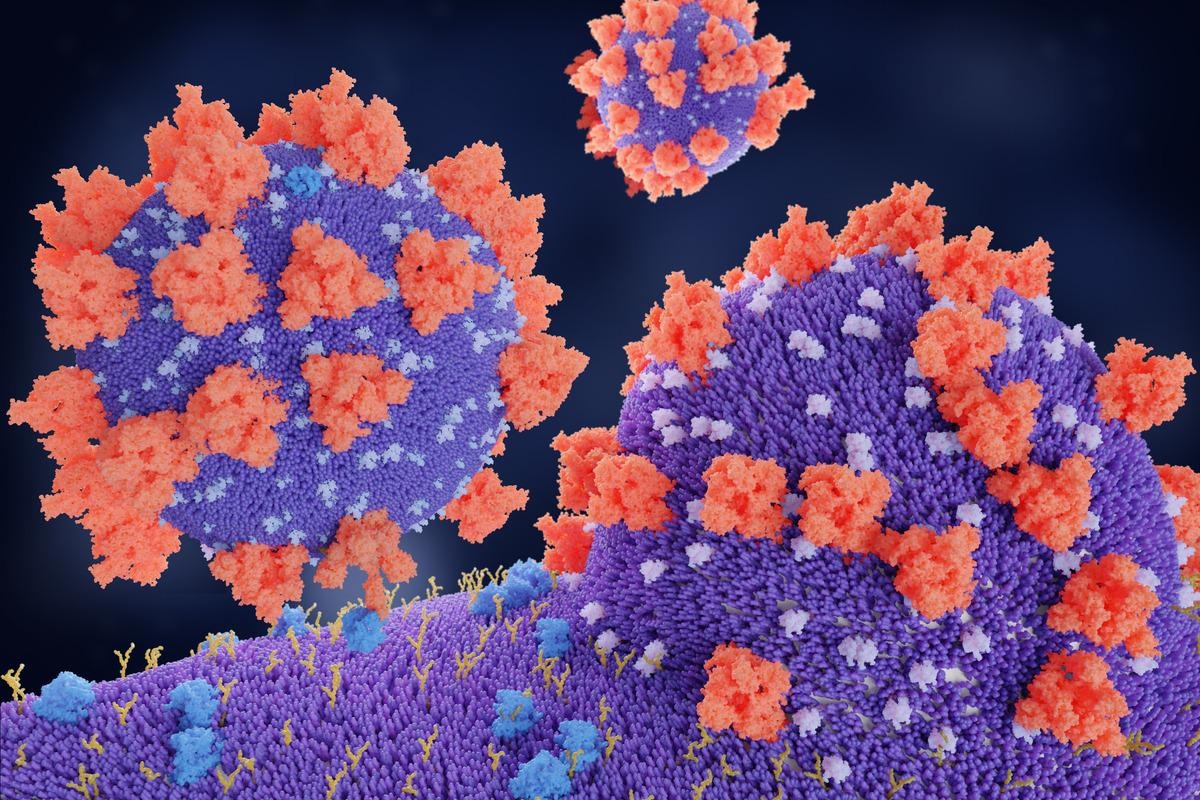 By Neha MathurReviewed by Danielle Ellis, B.Sc.Mar 9 2022
By Neha MathurReviewed by Danielle Ellis, B.Sc.Mar 9 2022In a recent study posted to the bioRxiv* preprint server, researchers evidenced the significance of calcium (Ca2+) in mediating the interaction between the coronaviruses (CoVs) fusion peptide (FP) and host cell membrane to provide insights into the mechanisms of viral entry.
 Study: The interaction of calcium ions with specific residues in the SARS-CoV fusion peptide and the regulation of viral infectivity. Image Credit: Juan Gaertner/Shutterstock
Study: The interaction of calcium ions with specific residues in the SARS-CoV fusion peptide and the regulation of viral infectivity. Image Credit: Juan Gaertner/Shutterstock

 *Important notice: bioRxiv publishes preliminary scientific reports that are not peer-reviewed and, therefore, should not be regarded as conclusive, guide clinical practice/health-related behavior, or treated as established information.
*Important notice: bioRxiv publishes preliminary scientific reports that are not peer-reviewed and, therefore, should not be regarded as conclusive, guide clinical practice/health-related behavior, or treated as established information.
Background
CoVs family is comprised of highly pathogenic viruses, including SARS-CoV, Middle Eastern respiratory syndrome coronavirus (MERS-CoV), and severe acute respiratory syndrome coronavirus 2 (SARS-CoV-2). The FP domain in the spike (S) protein of several CoVs, including SARS-CoV-2, is a highly conserved region that contains a hydrophobic LLF motif and many negatively charged amino acids that interact with Ca2+ ions to facilitate viral entry by interacting with the host membrane.
Several past studies have suggested that the Food and Drug Association (FDA)-approved Ca2+-channel blockers may be repurposed and used as coronavirus disease 2019 (COVID-19) therapeutics; however, how exactly Ca2+ ions mediate viral-host cell fusion events is unknown.
About the study
In the current analysis, researchers used mutagenesis studies to examine the FP1/FP2 region of CoVs. Additionally, they used molecular dynamic (MD) simulations to structurally interpret the interactions on the host membrane that regulated viral infectivity.
To this end, they synthesized FP mutants - D802A, D812A, E821A, D825A, E801, and D830A by making single charge-to alanine substitutions in CoV FP. Following transient expression of these FP mutants in Vero6 cells, their accumulation became comparable to the wild-type (WT) strain’s S protein levels, after which the researchers retrieved them using a cell surface biotinylation assay.
Treatment with trypsin exposed their S1/S2 cleavage site, and then they used a syncytia assay to test for fusion competency of FP mutants. All the single FP charged-to-alanine mutants exhibited fusion defects, as evidenced by the low number of fused VeroE6 cells, or syncytia, indicating that negatively charged amino acids residues within the FP contributed to its functioning.
They incorporated SARS-CoV-2 pseudoparticles with WT and single-charged-to-alanine mutant FPs that mimicked an in vivo environment facilitating examination of the functionality of these mutants. Luminescence indicated successful pseudoparticle entry/infectivity in host cells.
Study findings
A strong luminescence signal indicated that WT pseudoparticles had high fusion competency and hence successfully entered the VeroE6 cells (host) at physiological calcium levels. Similarly, pseudoparticles infected with E821A and D825A-mutants resulted in luminescence levels comparable to WT-containing pseudoparticles. This finding indicated that D821/D825 pair were inhibitory to membrane insertion, whereas the D812/D821 residue pair facilitated membrane interaction.
Contrastingly, pseudoparticles infected with the D802A, D812A, or D830A mutants could not infect VeroE6 cells, resulting in lowered luminescence. Pseudoparticles containing either the D812A or D830A FP mutants were non-infectious in the presence or absence of extracellular Ca2+. These results also associated residues D812A and D830A in FP function.
Together, these findings suggested that when cellular Ca2+ levels remained undisturbed, loss of an individual negative charge at positions D802, D812, or D830 was sufficient to cause a significant decrease in infectivity. Pseudoparticles infected with D802A or D825A mutants showed even more reduced infectivity with depleting Ca2+ levels.
This finding suggested that multiple negatively charged residues in the FP were involved in Ca2+-binding, and the loss of a single negative charge did not completely disrupt viral infectivity. In other words, the loss of extracellular Ca2+ reflected the loss of additional electrostatic interactions needed for FP function, resulting in a further decrease in infectivity.
The researchers confirmed that Ca2+ interacted directly with the FP using biochemical and biophysical techniques. Likewise, isothermal calorimetry helped determine the stoichiometry of this interaction. MD simulations showed the FP’s modes of Ca2+-binding in 1:1 and 2:1 stoichiometries for SARS-CoV and MERS-CoV, respectively.
The circular dichroism (CD) measurements confirmed that the FP adopted a conformation with a higher degree of alpha helicity in the presence of calcium and membranes. In this context, electron spin resonance spectroscopy (ESR) results revealed that lipid ordering increased upon FP insertion to create favorable conditions for membrane fusion; likewise, an enhanced lipid ordering occurred in the presence of Ca2+. Notably, a chelating agent ethylene glycol tetra-acetic acid (EGTA) removed extracellular Ca2+ causing a 50% reduction in infectivity of WT FP-containing pseudoparticles.
Conclusions
Overall, the study demonstrated that the CoV FP region is highly dynamic. The Ca2+ ions most likely enabled FP to adopt a proper conformation via its negatively charged amino acid residues, a structural change conducive for its insertion into the host cell membrane. Subsequently, in a Ca2+-depleted environment, the authors observed a defect in membrane fusion related to membrane level S features and likely interacted directly with Ca2+ ions.
The study established that Ca2+ is necessary to promote viral entry across multiple coronaviruses, including SARS-CoV, MERS-CoV, and SARS-CoV-2. Yet, a detailed structural understanding of how Ca2+ ions stabilize the FP for membrane insertion is missing.
Nevertheless, negatively charged amino acid sequences highly conserved across many CoVs in the FP peptide are therapeutically vulnerable targets that could prove quite beneficial in developing new COVID-19 treatments.

 *Important notice: bioRxiv publishes preliminary scientific reports that are not peer-reviewed and, therefore, should not be regarded as conclusive, guide clinical practice/health-related behavior, or treated as established information.
*Important notice: bioRxiv publishes preliminary scientific reports that are not peer-reviewed and, therefore, should not be regarded as conclusive, guide clinical practice/health-related behavior, or treated as established information.